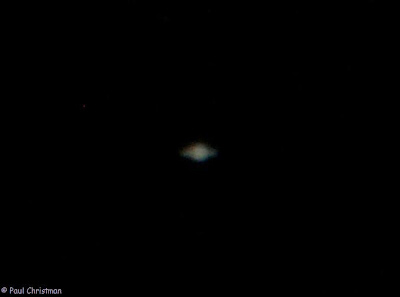Leo was just about due south, so I star hopped down to M65 & 66. It’s been awhile since I’ve seen any galaxy other than Andromeda, so I welcomed the pair. Trying to take advantage of the late rising crescent Moon’s absence, I also tracked down M51 and it’s companion, high overhead. Another tempting galaxy was M104, the Sombrero Galaxy, but I gave up after a couple unsuccessful attempts. It was time to warm up.
I came back for a look at Saturn, and wasn’t expecting much from it, but cranking the magnification up to 300x, I could finally see the rings opening up. I scoured for the Cassini Division, with no luck. Venus was getting high enough for decent observation, so I checked it out next. The thin crescent of early November has grown to almost a half disk, but the disk has shrunk in size. It hasn’t lost much of it’s shine from it’s peak magnitude almost a month ago, though!
 |
| Saturn with my Vivitar point & shoot camera. |
The Moon came up as the eastern sky was beginning to brighten around 6 AM. It was near Mercury that morning, but I forgot about that, and didn’t look for the inner planet. I spent half an hour observing Saturn, Venus, and Luna, the longest stretch I stayed outside that morning.
 |
 |
| Luna & Venus. |
The cold kept me from having much time at the eyepiece, but it was my first real observing session since November 2, two months earlier. I’d had a few short, observations, usually focused on one target, but not much of a chance to leisurely enjoy the sky above me. This was by no means leisurely, with a negative wind chill, but at least I had a few hours to work with.












I LOVE the moon photographs you took. You make a great astrophotographer there Paulie! Nicely done!
ReplyDeleteI'd like to get better images, but I don't have the budget for better equipment, and don't have the time to play around with some of the editing software. I don't even know if I could use processing on my pictures or videos. It's something I'd like to do, but it can wait.
ReplyDelete